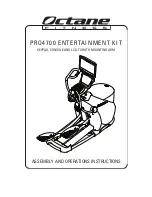
Connections
N-100
Owner’s Manual
ENGLISH
21
Connections
Connectors
CAUTION
Before connecting the N-100 to other electronic components, turn off the power to all the
components. Before doing this, set all volume levels to minimum (0). Otherwise, electrical
shock or damage to the components may result.
1
MIDI [IN] [OUT] terminals
Use MIDI cables to connect external MIDI devices to these connectors.
MIDI [IN]:
Receives MIDI data.
MIDI [OUT]:
Transmits MIDI data.
Refer to the “Connecting a Personal Computer” on page 22.
2
AUX OUT [L] [R](LEVEL FIXED) jacks
You can connect these jacks to a stereo system to amplify the N-100 or to a cassette
tape recorder to record your performance. Refer to the diagram below and use
audio cables to make the connections.
CAUTION
When the N-100’s AUX OUT jacks are connected to an external audio system, first turn
on the power to the N-100, then to the external audio system. Reverse this order when
you turn the power off.
When these are connected (with RCA pin plug; LEVEL FIXED), the sound is out-
put to the external device at a fixed level, regardless of the [MASTER VOLUME]
dial setting.
2
1
Since MIDI data that can be
transmitted or received varies
depending on the type of MIDI
device, check the “MIDI Imple-
mentation Chart” to find out what
MIDI data and commands your
devices can transmit or receive.
The N-100’s MIDI Implementation
Chart appears on page 37.
NOTE
About MIDI
MIDI (Musical Instrument Digital Interface) is a standard format for data trans-
mission/reception. It enables the transfer of performance data and commands
between MIDI devices and personal computers. Using MIDI, you can control a
connected MIDI device from the N-100, or control the N-100 from a connected
MIDI device or computer.
Use audio cables and adaptor
plugs with zero resistance.
NOTE
N-100
Stereo
AUX OUT
RCA pin plug
AUX IN
RCA pin plug
audio cable
















































